Strawberry – planting and care, growing from seeds
 Strawberry (lat. Fragaria) is a genus of herbaceous perennials of the rose family, Rosaceae, which includes both wild species – fragaria orientalis, fragaria campestris, fragaria viridis – and cultivated species that are not found in the wild – garden strawberry or pine strawberry. There are also species that grow in nature and in garden – woodland strawberry and musk strawberry. The name of the plant comes from a word “straw” as its tiny yellow seeds scattered over the surface of the berry look like a straw. The plant was first described in 1553 by Jerome Bock, superintendent of the botanical garden in Zweibrücken.
Strawberry (lat. Fragaria) is a genus of herbaceous perennials of the rose family, Rosaceae, which includes both wild species – fragaria orientalis, fragaria campestris, fragaria viridis – and cultivated species that are not found in the wild – garden strawberry or pine strawberry. There are also species that grow in nature and in garden – woodland strawberry and musk strawberry. The name of the plant comes from a word “straw” as its tiny yellow seeds scattered over the surface of the berry look like a straw. The plant was first described in 1553 by Jerome Bock, superintendent of the botanical garden in Zweibrücken.
It is believed that strawberries appeared in the Tertiary period in East Asia, and then spread across America and Eurasia. We will tell you about such a genus representative as garden strawberry (fragaria ananassa). This species of strawberry is the result of crossing the Chilean strawberries and Virginia strawberry (scarlet strawberry). Today there are more than 10 thousand varieties of this species.
Description of garden strawberry
The root system of strawberries is well-developed, branched, fibrous. The leaves of strawberries are large, green, trifoliate, on petioles up to 9.8 inches long. Terrestrial part of the strawberry has three types of shoots:
- cornicle that is short annual shoots with the heart-shaped apical bud. The cornicles also have side axillary bud and crown of a few leaves;
- stolons of the strawberry are creeping annual shoots that are the organs of vegetative reproduction. They appear at the end of the flowering period;
- flower stalks that grow in April from generative buds.
Polyanthous corymbose inflorescences are composed of the five-petalled bisexual white flowers. Some varieties of strawberries have flower stalks above the stems. The fruit of the strawberry which is called “berry” is a carpophore on the surface of which there are small brownish nuts that are true fruits of strawberries. Berries can be of all shades of red color, although there are varieties with white or pink fruits with a reddish or white pulp. At one place the plant can grow for 4-5 years. Only blackcurrant has more vitamin C than strawberry, but it has higher folic acid content than grapes or raspberries. Strawberries contain iron four times more than apples or pineapple.
In our article you will find out how to grow strawberry in the garden, how to care for strawberries, that is, how to water the strawberries in hot days and how to feed strawberries during flowering to gather a rich harvest, what fertilizers are preferable for strawberries. We will try to tell you everything that a novice may need to grow this berry that has become lately as popular as musk strawberries, raspberries, currants, gooseberries, blackberries and blueberries.
Strawberry planting
When to plant strawberry
Strawberries can be planted at any time during the growing season, but the best time is the end of summer or early autumn and early spring. If you plant the strawberries in late August or early September, it will have enough time to take root before winter and it will bring a rich harvest next year. However, in areas with unstable, frosty, long and snowless winters it is better to plant strawberries in spring as soon as the soil gets warm. The site for strawberries should be sunny. Do not plant strawberries after potatoes, cabbage, cucumbers. Also you should not grow the strawberries on the site where tomatoes, peppers, eggplant, and other solanaceous were grown last year. It is not advisable to plant the strawberries next to the raspberries.
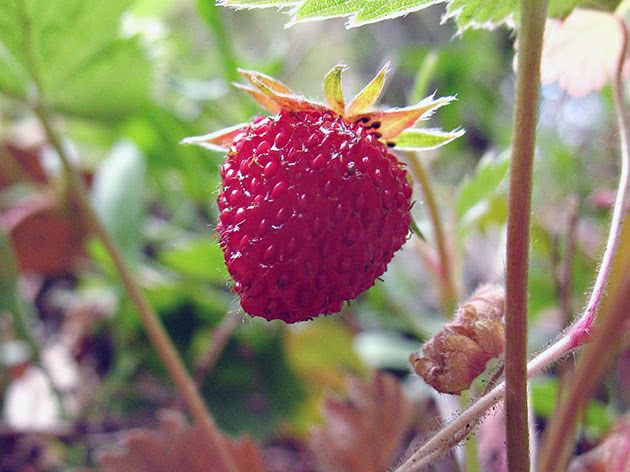
Soil for strawberries
There are no special requirements for soil: with good care strawberry can grow everywhere except of marshy places and too dry, sandy areas, but if you have the opportunity to choose, it is better to plant strawberry on slightly acid loam or sandy loam soils, as long as it is enough wet, nourishing and breathable. Sites where water stagnates are not suitable. The water table under the site with strawberries should not be higher than 2.3-2.6 feet. The pH of the soil should be within 4.5-5.5 units. The best precursors for strawberries are beans, onions, garlic, marigolds, lupins, oats, rye, peas, beets, carrots, radishes, parsley and dill. But it is better not to plant strawberry after the cucumber, solanaceous crops and crucifers.
Planting strawberry in spring
Planting of strawberries in spring requires preparation of the site in autumn. Dig the soil by pitchforks to a depth of 10-12 inches, removing roots of weeds and adding organic fertilizers: 11 pounds of compost, peat or rotted manure per 11 ft². In addition to organic fertilizers you can add to the soil a complete mineral fertilizer at the rate of 1.4 oz of double superphosphate, 0.7 oz of potassium sulfate and 11 pounds of wood ash per 11 ft². And if strawberry is planted in spring, organic fertilizers are added in autumn, and mineral fertilizers are added in spring. If the soil in the site is characterized by high fertility, there is no need to add fertilizer.
Large-fruited strawberry should be planted at a distance of 8-12 inches between the bushes, keeping the row width of 2.2-2.6 ft, small-fruited varieties are planted according to the scheme of 8 by 12 inches. Make the hole of about 8 inches in diameter and 10-12 inches deep by a hoe, pour about 1.75 pints of water into each hole and immediately immerse the bush seedlings in the hole. Then fill up the hole with soil and gently tamp it. Put the seedlings into the soil at the level of the root neck without immersing the crown bud into the soil, otherwise the plant will begin rotting. If the bush is immersed in the soil not deeply enough, the plant may die from roots drying. After planting, the soil between the rows should be well loosened.

If you plant strawberries in a dry soil, pour it two or three times before it takes roots. This should be done every day in the evening. Besides, at first strawberry bushes should be protected from direct sunlight.
Strawberry planting in autumn
The site for strawberry planting in autumn should be prepared two or three weeks earlier. The preparation procedure is the same as in spring, but organic and mineral fertilizers should be added in the soil simultaneously and you can apply only a half of the dose of the mineral fertilizers. Strawberry seedlings are planted in the same way as in spring, but when shrubs take root, in winter the rows should be covered by a 3- 4 inch layer of rotted manure or straw thick for the roots of strawberries not to get frozen.
Care for strawberry
Growing of garden strawberry
Growing strawberries in the open ground involves weeding, earthing up, hoeing soil between the rows, fertilizing and watering, a preventive or therapeutic treatment of diseases and pests, as well as trimming of bushes and site preparation for the winter. Sometimes the bush of last year's planting is pushed out of the soil during winter frosts, and in spring, as soon as conditions permit, it is necessary to sprinkle the roots with soil and gently tamp it down, then it is desirable to carry out hoeing of the soi between the rows and around the bushes. Eventually, the bed should be weeded and loosened when a crust is formed on the surface or weeds appear. During the growing season it is necessary to loosen the rows 7-8 times, and the soil around the bushes should be loosened no less than 5 times. Mulching the site with reeds, tree leaves, peat or rotted straw will make care for strawberries easier. This measure protects the soil from the crust formation and significantly reduces the quantity of weeds in the garden. Bushes that grow at one place for five or more years should be transplanted to another location.

Strawberry during flowering
Strawberry flowering begins in a week or two after the appearance of the flower stalks, or 25-30 days after the start of the growing season. Each normally formed crown bud produces one inflorescence, each corymb has from five to twenty-seven flowers. One flower lives from 4 to 6 days, but the flowering process can last up to three weeks – the duration depends on the temperature, humidity, light intensity and duration of daylight, feeding and varieties of strawberries. Care for strawberry during flowering does not have any peculiarities. Strawberry fruiting starts in a month after the beginning of flowering.
Strawberry watering
Growing strawberries implies regular and sufficient watering as the strawberries are water-loving plants. The best method of irrigation is artificial. You can also make furrows about 5 inches deep in the middle of each row, pour some water into them, then plug the furrow and loosen the site. If you use a watering can, take off the sprinkler and pour water under the roots of the bushes, trying not to pour on the leaves. Water should be of the same temperature as the air, and if you have the opportunity, try to pass it through a magnet as this measure helps increase the yield and berry size. To determine whether you should water the strawberries, check the soil moisture at the depth of 8-12 inches: if the soil crumbles in your hands, it means that the plant needs moisture. The average interval between watering should be between 7 to 10 days for growing shrubs, and when berry forming begins, reduce the interval up to 5 days. In rainy weather, the interval needs to be adjusted in accordance with the ground conditions.
Strawberry fertilizing
In order to ensure good growth and high yield of strawberries, you should fertilize it regularly. What fertilizers should be used for strawberry? You should use mineral and organic fertilizers like humus, ash, bird droppings. The first dressing is carried out in spring, as soon as the snow melts, and it consists of 1.75-3.5 pints of a solution of complex mineral fertilizers for a young strawberry bush and from 3.5-8.8 pints for an adult bush.
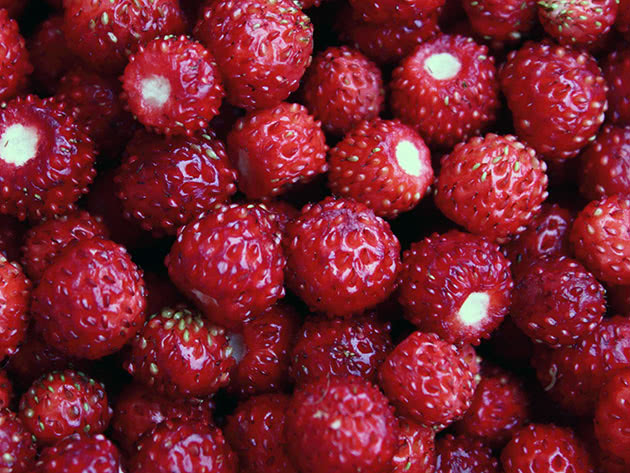
The second dressing is carried out when flower stalks appear. The solution consists of mullein diluted by 6 times, and bird droppings diluted by 20 times. Then the solution is fermented for a week. A half of a cup of wood ashes are added into 2.2 gallons of the solution. The usage of fertilizers is the same as during the first dressing.
When strawberries bloom, it is fed with the same fertilizer as before flowering, but mullein should be diluted not by 6 but 8 times.
In mid-August, strawberries start forming flower buds for the next year, and at this time nitrogen component should be excluded from fertilizing solution, otherwise strawberries can start growing instead. In 2.2 gallons of water you should dissolve 1.8 oz of daily amount of superphosphate extraction and add a half of a cup of the same ash. Do not use fertilizers containing chlorine as strawberries badly react to it.
Before each dressing the site should be watered, without wetting the plant leaves or crown. Everbearing strawberries require larger number of feedings than common varieties of the plant, since flower buds of future harvests begin forming during the first harvest ripening.
When to replant the strawberry
As already mentioned, strawberry replanting is performed every 4-5 years, but everbearing varieties require more frequent replanting – every two years. September is the best time for this procedure. Strawberry is replanted in the same way as the primary planting: strawberry seedlings are dipped into the prepared hole, then they are filled with the soil remaining the crown bud above the surface. Before the frosts the rows are mulched for cold protection of strawberry roots.

Strawberries after harvest
When the fruiting ends, the strawberry begins the intensive growth of bush leaves and runners. At the same time, the plants accumulate nutrients that they will need in winter, as well as new fruit buds are formed. During this period, it is important to create optimal conditions for strawberries by supplying feeding and adequate moisturizing.
Strawberry propagation
Most varieties of strawberry are propagated by runners (stolons). The varieties that do not have runners are propagated by bush dividing and by seeds.
Strawberry propagation by runners
When after fruiting the strawberries start growing runners, the soil around the bushes should be weeded, watered and loosened. A couple of annual or biennial healthy runner (daughter) plants should be lightly pressed into the soil, sprinkled with loose soil so that the crown is left under the soil surface to take root. Rooted runner plants are dug out in September and transplanted to a permanent place. Sometimes the daughter plants are separated from the mother plant and grown in the breeding beds under a canopy of garden fabric, protecting them from the direct sunlight. 3-4 leaves are left on the daughter plants that do not have any roots yet, and only 2 leaves are left on the rooted daughter plants. It is done for the plant to spend resources on the root development, but not on the leaves. In two weeks the cover is removed, and in September daughter plants with a clod of soil are transplanted in the strawberry beds.
If you decide to buy strawberry seedlings, keep in mind that a good seedling has at least 3 leaves, a well-developed runner, and roots about 2 inches long.

Seed propagation of strawberries
Large fruited and small-fruited remontant varieties that do not have runners are propagated in a generative way. In March strawberry seeds are sown on a wet, compacted compost and gently pressed down to the surface. The container with seeds is covered with glass or foil and kept for three days in the vegetable drawer of the refrigerator, and then located in a warm place with a temperature of 64-68 ºF. From time to time the soil is moistened by the sprayer. When shoots appear in a month, remove the glass, put the container in a light place at 59-62 ºF for the week, and then restore the previous temperature of 64-68 ºF. At the stage of development of 3-4 leaves strawberry seedlings are pricked out in the peat-compost pots, and in the second half of May, when there is no threat of returning frosts and the seedling are adapted to the outside conditions, they are planted into the beds.
Strawberry propagation by bush dividing
Also strawberry varieties that do not have runners are propagated by bush dividing. In spring or after fruiting, strong well-developed bushes of strawberries are dug out, their roots are cleaned from the soil and cut by the knife so that at each plant has a runner, good white roots 2-2.3 inches long and at least three leaves. Old, blackened roots are pruned, and after that new pieces are planted according to the previously described scheme.
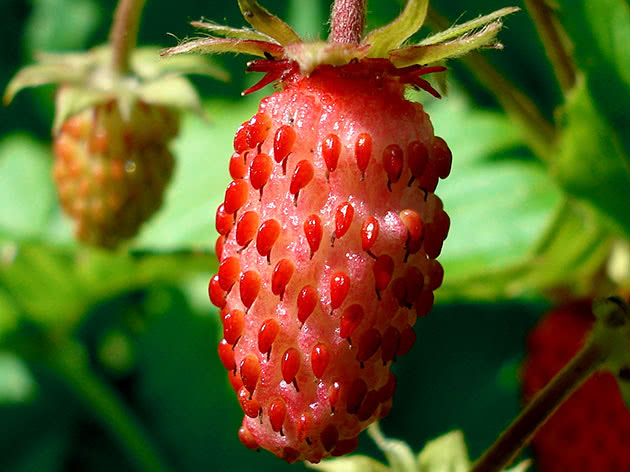
Strawberry pruning
When to prune strawberry
There is no single opinion among gardeners about strawberry pruning. Some gardeners argue that it is necessary to prune strawberry, but the other gardeners have an opposite view. On the one hand, leaves feed bush. The more leaves the bush have, the stronger the plant will be. On the other hand after fruiting strawberries should get ready to harvest in the next year, but growing runners and daughter plants that appear after fruiting take away resources that are necessary for the formation of next year’s fruit buds. That is why the strawberry pruning is an absolutely necessary procedure. However, bushes will not sustain winter cold without leaves since they are heat insulators preventing strawberry beds from being winterkilled.
Strawberry is a perennial plant. Its leaves gradually dry up, and new leaves replace old ones. The replacement cycle of old leaves by new ones lasts about 60 days. Therefore the leaves are cut just after collecting of the main yield in August, without waiting for the remained berries to ripen, and then strawberries will have enough time to grow new leaves before frosts. If you did not prune the strawberry in time and now you are afraid that there is no time for new leaves to grow, do not cut the old leaves and let them be on the plants.
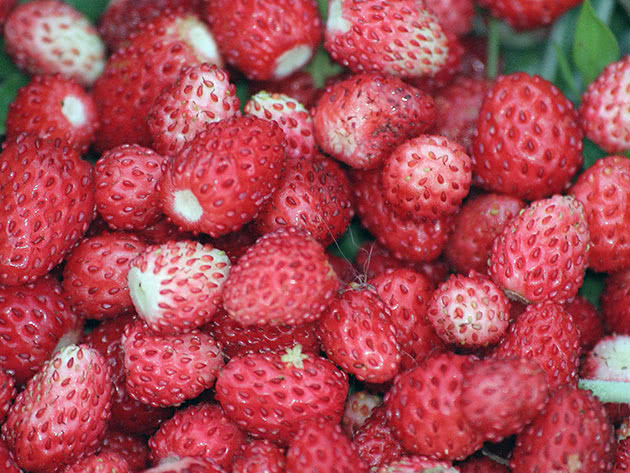
How to prune the strawberry
The leaves are pruned up to the ground for the pests or pathogens not to appear in their remains. The cut leaves and runners are put in a compost pit, but if you notice pests or signs of the disease, it is better to burn them.
If you properly care for your garden and your plants are not affected either by strawberry pests or disease, there is no need to prune the strawberry every year and you can do it every two to three years. Young bushes are better not to be pruned since cutting makes them very weak.
Strawberry in autumn
After pruning strawberry beds should be processed by insecticides or fungicides. While building up a new leaf mass the plants need watering, weeding and hoeing, and the roots of strawberries require feeding with mineral and organic fertilizers.
Before cold weather coming in areas with a cool climate, the beds of strawberries should be covered with a solid layer of straw manure or fallen leaves 2-2.7 inches thick to protect the plant leaves and roots from freezing in case of very cold and snow-free winter.
In the southern regions the following way of strawberry cold protection is used: sorghum is sown in spring from east to west in every 4-5 rows of strawberries. Thus, in summer strawberries are shaded from the sultry sun, while in winter it contributes to snow retention that not only protects the strawberries from frost, but also accumulates moisture in the soil.

Strawberry pets and diseases
Strawberry diseases
Unfortunately, the strawberry is often affected by various diseases. We will introduce you to the most frequent strawberry diseases.
Fusarium wilt affects both land-based part of the plant and the roots, causing the plant to gradually change color, wither and dry. The ovaries cease to grow, the leaves and runners darken. Heat is a favourable condition for the fungus development. The source of the disease may be weeds, some vegetable crops or the soil in which the fungus can remain viable for several years if you do not remove plant remains from your garden in time.
Control measures. Follow crop rotation principals and carefully choose predecessors. Once symptoms appear, immediately apply fungicides.
Verticillium wilt can destroy a half of the bushes on the plantation for 2-3 years, if not eradicated. This fungus disease attacks vascular system of the plant, root collar, daughter plants and roots. At first, the infected bush "sags", then leaves lie flat, and in the center of the bush there are leaves that look like being attacked by chlorosis. Brown vascular ring can be seen on the rhizome cut. Most often, the disease appears during ovary growth. The main source of pathogens is soil, but also weeds and other vegetable crops can be the disease carriers.
Control measures. Follow crop rotation principals. When the disease is noticed, apply fungicides. Use a drip irrigation system.
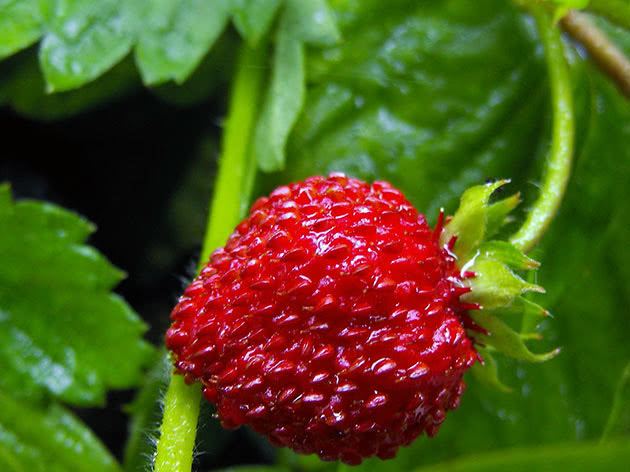
Lanarkshire disease causes reddening of the vascular cylinder of the root. The disease appears during dry days at the beginning of summer. At first, lower leaves of the plants start wilting, meanwhile the stele of the root turns red, lateral roots die off over time, and large roots blacken at the bottom and become similar to the rat's tail. Foliage turns a bluish-reddish color and begins withering prematurely, and the young leaves become smaller in size. The pathogenic agent of the disease penetrates into the root system from the soil, and mycelium of the fungus develops in wood root, growing and filling a vascular tissue. Sometimes disease is spread through other planting material.
Control measures. To avoid the disease, strictly follow crop rotation principals, use only healthy seedlings for breeding. As a prevention measure, apply fungicides containing Trichoderma lignorum through a drip irrigation system. Infected plants and soil under them should be processed by fungicides.
Phytophthora crown rot can have a negative impact on the quantity and quality of the yield, reducing it by 15-20%, and sometimes it can even destroy it. This rot affects all ground parts of the plant – flower buds, buds, fruits, leaves, tops of stems and growing points. Berries of the infected bushes become bitter, hard light brown spots appear on immature berries. Gradually, the fruit gets dry and mummified. During wet weather a thick white coating is formed on the affected parts. Stem coarsens and dies. The first symptoms of the disease can be observed usually in June and the disease reaches its maximum development in July.
Control measure. Strictly follow crop rotation principals, carefully choose seedlings for breeding, do not break the rules of strawberry maintenance. In case the first symptoms of disease are observed, treat the plant and the soil under it with fungicides.
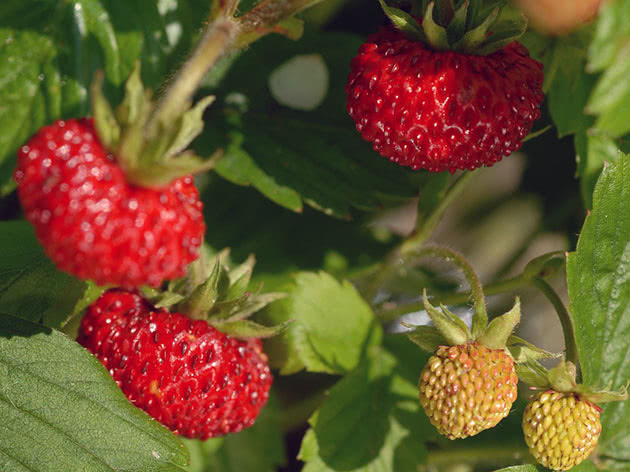
Gray mold, or botrytis rot, is very widespread. The favourable circumstances for this disease are warm and humid summer, a dense plantation with poor ventilation, strawberries are grown for many years at the same site. Gray mold can destroy a half of the berry harvest. The disease affects leaves, buds, berries, flowers, ovary and peduncle: soft brown spots appear on them and then they rapidly increase in size. The berries get dry and mummified, stalk and ovary get covered with moist spots. Strawberry rots.
Control measure. As a preventative measure, in spring the site should be processed with fungicides. After flowering, if summer is rainy, the processing is repeated. Well, of course, bushes affected by botrytis have to be removed from the site and burned for the infection not to spread to other plants;
Powdery mildew, or oidium, affects the leaves, stalks, runners and berries of strawberries. It starts its development from the underside of the leaf surface. You can determine mildew by loose white coating covering the affected parts of the plant. Subsequently, brown or ‘tan’ necrosis appear at these places. Runners curl up, chlorotic leaves appear, the berries turn dry, ugly and underdeveloped, have the smell and taste of mushrooms.
Control measures. As soon as you notice signs of disease, apply fungicides.

Besides above mentioned diseases, the strawberry can be affected by such diseases as anthracnose, spotting (brown, white or brown), black, root, and white rot.
Strawberry pests
Strawberry has lots of pests. We will talk about the most annoying pests:
Strawberry root weevil is almost black, tiny beetle up to 0.1 inch long that overwinters under fallen leaves or in the soil clods. In spring, after waking up, it eats the leaves of strawberries, making holes in them, and the females lay their eggs in the buds. Strawberry weevil is a disaster, as one female can lay from 50 to 100 eggs over the season, and the larvae gnaw buds, depriving you of the long-awaited harvest berries.
Nettle-leaf weevil is bright green in color and reaches a length of 0.5 inch. It eats leaf margins. Its larvae hurt the roots of strawberries in the second half of the summer.
Control measures. Not later than one week before the beginning of flowering, and immediately after gathering harvest of berries, you should apply insecticides. Keep the strawberry beds free from weeds and grass and do not forget to loosen the rows;
Strawberry mite damages leaves of the plants making them look oily and frown. Strawberry berries become smaller. Bushes that are severely affected by mites die. The maximum amount of mites is reached in August. During the season, they produce four or five generations.

Control measures. Before planting, you should warm seedlings for 15 minutes in water at the temperature of about 113 ºF, then wash them with cold water and air dry in the shade. Damaged plants are treated in early spring with a solution of 2 oz of colloidal sulfur in 2 gallons of water at the rate of 0.4 gallon per 11 ft². Use acaricide for the second processing. If the entire site is infected by mites, after harvesting, the leaves of plants are mowed and burned, soil is heavily moistened, and then fertilizers are applied. Then the site should be processed with a solution of 2 oz malathion in 2 gallons of water;
Stem and strawberry nematodes also cause significant damage to strawberries. Stem nematode is a transparent worm up to 0.04 inch long, damaging the stems, petioles and leaf veins from the inside, causing them to bulge. As a result, affected parts become shorter and curved, fall behind in growth, frown, crack and die. Strawberry nematode lives in the base of the leaves and buds of strawberry, making the flower stalks and leaf petioles shorter, thickened and folded. Affected bushes do not bear berries or berries look deformed.
Control measures. Calendula deters nematodes, so it is advisable to plant it near the strawberry beds. Affected bushes must be removed and burned. As a preventative measure, purchased seedlings should be washed with water to remote the soil from roots, then the seedlings are immersed in brine for 15 minutes (5 tablespoons per 1.75 pints of water), rinsed and planted into the soil.
In addition to the pests, which we have described, the strawberry can be attacked by slugs and snails, red ants, centipedes, leafhoppers and other pests.
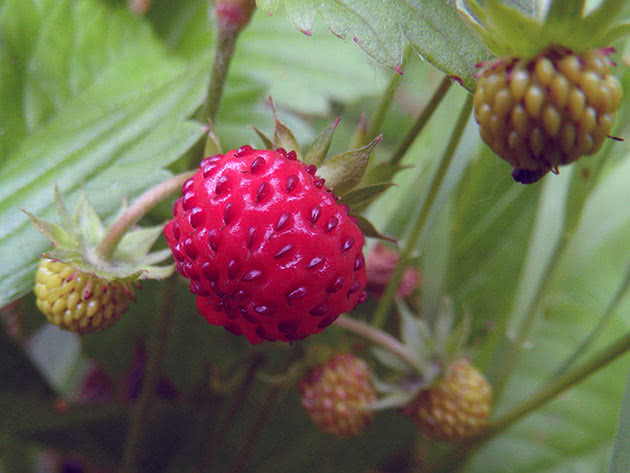
Strawberry treatment
If you do not want strawberry to have diseases and pests, try to carry out preventive treatment of plantations in the early spring and autumn every year. In spring, before spraying strawberry beds, remove the remains of last year's mulch, cut and burn all of last year's leaves, and only after that treat the beds with the copper-containing drugs as Bordeaux mixture or by fungicides. Also preventive treatment is carried out before flowering and at the time of foliage mass regrowth. One or two procedures with a break of 2 weeks should be carried out after flowering. You can use fungicides to get rid of insects. As a preventative measure against pests you can apply insecticides. The number of treatments is determined by the level of the site infection. The higher it is, the more frequent preventive spraying of strawberries should be.
Strawberry varieties
If you are going to grow strawberries on your site, at first you should pick the right varieties the number of which is countless. Ideal varieties do not exist, since each has both advantages and disadvantages. One of well-known breeders believes that the ideal variety must include 56 signs, each of them will suit you. Today, it is impossible, but anyway this task is in progress.
Based on the maturity terms garden strawberry is classified into early-season, mid-season, late-season and everbearing. It is enough to have 5 varieties with different ripening terms to have a stable harvest of berries throughout summer. We offer you the description of some varieties that you might choose for your garden.
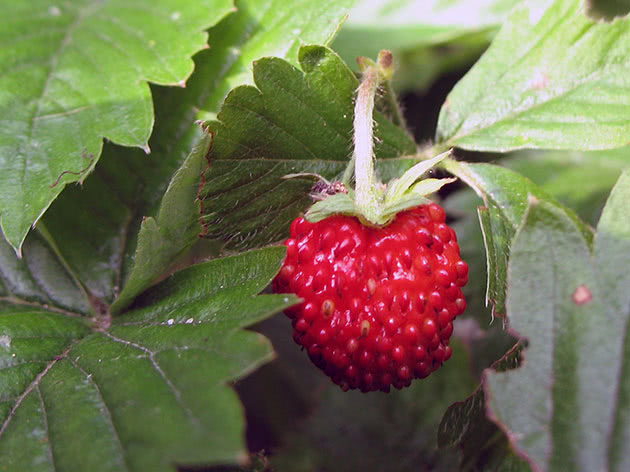
Early-season strawberry varieties
- Kokinskaya is an early-season, winter-hardy, high yielding variety with large, dark, red, shiny berries of conical shape. The flesh is firm, tasty and juicy;
- Festival chamomile is a high yielding variety of Ukrainian breeding with sweet large, round-conical berries of bright red color. The flesh is dense, tasty and fragrant;
- Elvira is a variety of Dutch breeding with large, round, shiny, red berries with a weight of 2 oz. The flesh is dense, red, very sweet and aromatic. The variety is resistant to fungal diseases;
- Kent is a Canadian variety of strawberry with the rounded-conical, bright red berries with a dense, fragrant and sweet flesh. The variety is resistant to low temperatures, powdery mildew, gray mold and root diseases. It bears fruits again in August or September;
- Honeoye is a very early high-yielding and winter-hardy American variety for areas with non-black soil. Berries are fragrant, large, sweet, juicy and of an average elasticity. The variety is also characterized by high resistance to disease.
In addition to above described varieties, also the following early season varieties are popular: Wim Zant, Daroyal, Camarosa, Lambada, Kimberly, Clery, Honey, Alba, Alinta, Early Crimea and others.
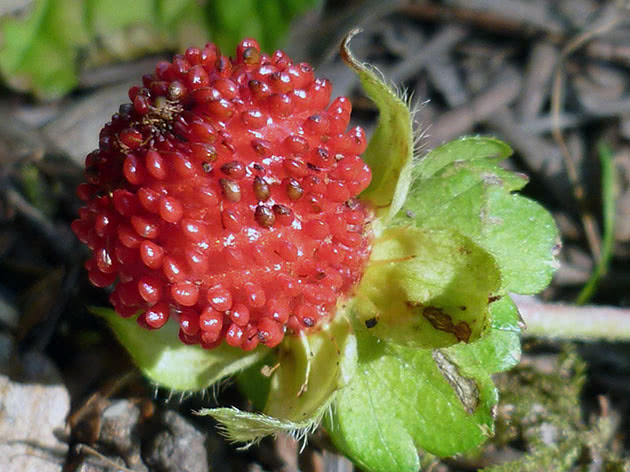
Mid-season strawberry varieties
- Lord is a high-yielding, cold-resistant, self-pollinating and resistant to botrytis variety of English selection with a stretched period of maturation and ripening of the fruit. Berries are large, round-conical, bright red, sweet and fragrant with a dense flesh;
- Harvest, as the name implies, is a high-yielding, large-fruited, winter hardy and resistant to fungi variety with beautiful and tasty berries that do not become smaller in size until the last collecting;
- Venta is an elite, high-yielding and frost-resistant Baltic variety with very beautiful and large berries of round shape and bright red color that in hot days turn dark red. The variety is resistant to mites;
- Juan is one of the most large-fruited varieties with very large berries, sometimes reaching the size of a medium apple. Berries are round, bright red, shiny. The flesh is very dense, sweet and light red. The variety has high yield and resistance to frost, as well as the ability to adapt to adverse weather conditions;
- Cambridge Favourite is an English high yielding and resistant to fungi variety with large, shiny, aligned berries of regularly rounded conical shape and bright red color. The flesh is dense, light red with a delicious sweet-sour taste.
In addition to these varieties, the following mid-season varieties are also popular: Junia Smaids, Holiday, Masha, Gigantella, Festival, Fireworks, Pearl, Korona, Polka, Tago, Susie, Figaro, Annapolis, Marshall, Darselect, Elsanta, Sultan, Turid and others.

Late season strawberry varieties
- Borovitskaya is a self-pollinating, high-yielding, winter-hardy variety that is resistant to diseases. It has very large, dark red, doubled berries with a groove in the middle. The flesh is firm, juicy with sweet taste;
- Vima Tarda is a high-yielding, large-fruited, winter-hardy and disease-resistant, Dutch variety with very large, blunt-ended, shiny berries. Flesh is dark red, extremely tasty. Berries do not become smaller in size until the last collecting;
- Redgauntlet is a high-yielding, winter-hardy, mid-season and disease-resistant variety of English breeding of wide cone shape and with large, dark red, shiny berries. The flesh is bright pink, dense, sweet and fragrant;
- Vicoda is one of the best winter-hardy varieties of the Dutch group, resistant to white mold and spotting. Berries has weight up to 4.2 oz. They are comb-shaped, dense, dark-red, very delicious;
- Vima Xima is one of the new Dutch high-yielding varieties with large, beautiful and very sweet berries of dark red color. The pulp is also dark red, dense and juicy. The variety has disease resistance. Vima Xima forms few runners that make it easy to care for strawberries in the garden.
Among late-season varieties of strawberries, the following are also popular: Bohemia, Maxim, Symphony, Mieze Schindler, Mara Des Bois, Chandler, Chamora Turusie, Maestro, Princess Diana, Carnival, Profusion, as well as varieties with white berries Pineberry and Anablanca.

Remontant varieties of strawberries, or day-neutral varieties
- Brighton is winter-hardy and resistant to fungi American variety. The duration of daylight does not affect on flowering and fruiting. The period of its continuous fruiting is 10 months. Berries are red, as if varnished, large and with a sweet-sour taste;
- Crimean remontant is one of the best Russian varieties of remontant strawberries. It has winter hardiness and disease resistance and bears fruits from late May until the cold weather. The berries are not reduced in size to the last collecting. When fully ripe, fruits get a smell of wild strawberries. Berries are very beautiful, dark red, dense and juicy;
- Queen Elizabeth II is the best among varieties of remontant strawberry up to now. Berries are large, fragrant and dense. The variety has a wide popularity among gardeners;
- Garland is a new continuously flowering and everbearing variety that does not depend on the length of daylight and weather conditions. The berries are large, dense, very fragrant and delicious. The variety can be grown vertically on a trellis or in hanging pots;
- Pineapple is a resistant to disease Polish variety that bears fruits for the first time in mid-May, and the second time is at the end of October. Orange berries have a turbinate shape, weight of 2 oz and aroma and taste of wild strawberries.
Besides above described varieties, there are also such remontant varieties as Consul, Felicia, Aisha, Albion, Thelma, Florin, Evie Delight, Sweet Evie, Royal Visit, Autumn Fun, Selva and others.
